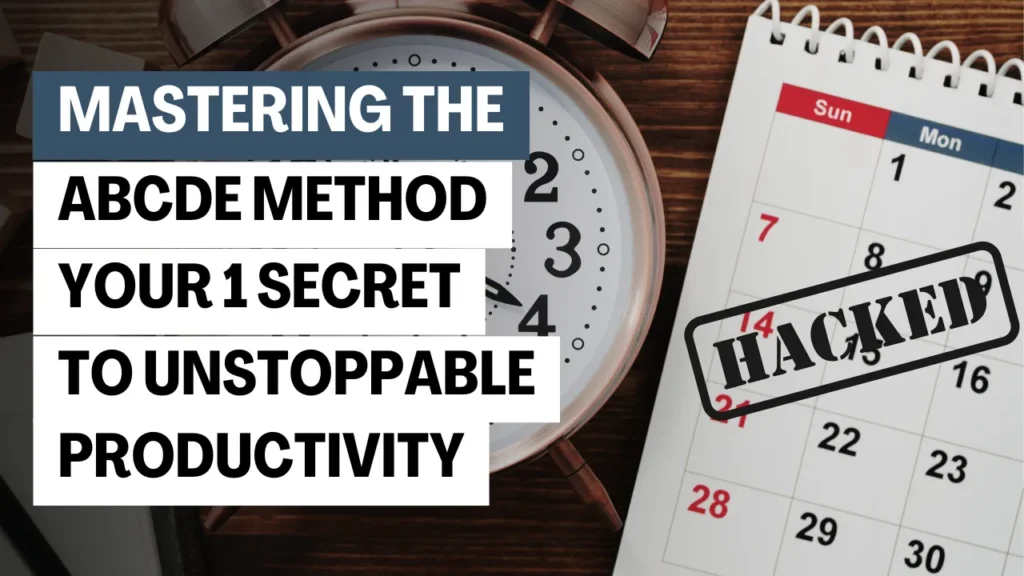Physical Address
304 North Cardinal St.
Dorchester Center, MA 02124
Physical Address
304 North Cardinal St.
Dorchester Center, MA 02124

In a world of endless to-do lists and competing priorities, the ABCDE Method offers a simple, effective system for managing tasks with clarity and purpose. This strategic framework categorizes tasks from A to E based on importance, creating a clear roadmap to prioritize what truly matters while eliminating distractions.
Developed by productivity expert Brian Tracy, the ABCDE Method simplifies complex time management techniques, making them accessible and practical. Trusted by professionals across industries, this proven system helps streamline daily operations and achieve meaningful results.

Unlike generic to-do lists that treat every task equally, the ABCDE Method introduces a hierarchy. It helps you triage your tasks, ensuring your time is allocated to what truly matters. This hierarchy prevents the overwhelming trap of attempting to accomplish everything at once.
Prioritization reduces stress and boosts efficiency by bringing clarity to your tasks, replacing uncertainty with focus. The ABCDE Method provides a structured framework to turn chaos into manageable priorities, reducing mental strain and improving confidence.
Focusing on A-level tasks first aligns with research showing that single-tasking enhances productivity. This approach enables deep work, where concentration peaks and distractions disappear, maximizing your efforts and ensuring meaningful outcomes.

Begin by creating a comprehensive list of everything you need to accomplish. Don’t worry about order—just capture every task on paper or a digital tool.
For each task, determine its category:
Within each category, rank tasks numerically (A1, A2, A3, etc.). This added layer ensures you tackle the most pressing priorities in a logical sequence.

A-level tasks are the cornerstone of your daily productivity. These high-stakes activities are the ones that directly drive your objectives forward, producing tangible and impactful results. Whether it’s completing a critical project, meeting a client deadline, or preparing for an important presentation, A-level tasks are non-negotiable. They demand immediate attention and often have significant consequences tied to their completion.
Neglecting these top-tier priorities can lead to a cascade of adverse effects. Missed deadlines can erode trust and credibility, strained relationships may hinder collaboration, and lost opportunities can stall progress on your broader goals. The repercussions of ignoring A-tasks often extend far beyond the immediate moment, undermining long-term success and creating a cycle of unnecessary stress. Addressing these tasks with focus and urgency ensures that the most critical aspects of your day are handled effectively, setting the stage for sustained achievement.

B-level tasks play a pivotal role in shaping long-term success and are a critical component of the ABCDE Method. These tasks often encompass activities like strategic planning, skill-building, or networking—elements that, while not immediately pressing, are instrumental in achieving future goals. Within the ABCDE Method, B-level tasks serve as the scaffolding for sustained growth, enabling you to strengthen your capabilities, broaden your opportunities, and prepare for larger challenges ahead. Though they may not carry immediate consequences, neglecting them can stall progress and leave you unprepared when key opportunities arise.
To effectively manage and plan for B-level tasks using the ABCDE Method, it’s essential to allocate time for them during periods of lower pressure. These tasks should not compete with the urgency of A-level priorities but instead find their place in your schedule where you can approach them thoughtfully and consistently. By leveraging the ABCDE Method, you can integrate these long-term tasks into your routine, ensuring steady progress without diverting focus from more urgent matters. This balanced approach to the ABCDE Method allows you to address immediate priorities while laying the groundwork for future success.

C-level tasks often blur the line between essential activities and time-wasters, frequently masquerading as productive work. These tasks may appear necessary at first glance, but a closer evaluation often reveals that they contribute little to your overarching goals and serve more as distractions than valuable efforts. Recognizing and categorizing these tasks appropriately is a key aspect of mastering the ABCDE Method.
Common examples of C-level tasks include responding to non-urgent emails, attending optional meetings, or engaging in minor social interactions. While these activities might feel productive, they typically lack a significant impact on your objectives. By identifying and managing these tasks effectively within the ABCDE Method, you can prevent them from siphoning time and energy away from higher-priority work.

Delegation, a cornerstone of the ABCDE Method, is key to optimizing your productivity and focusing on tasks that truly require your expertise. Category D tasks often include administrative work, repetitive duties, or logistical details that do not demand your unique skills or decision-making. Identifying these tasks and assigning them to capable individuals allows you to free up time and energy for higher-priority responsibilities.
To delegate effectively without losing control, it’s essential to approach the process with clarity and precision. Begin by clearly defining expectations and outlining the desired outcomes. Provide the necessary resources, tools, or information the individual may need to complete the task successfully. Establish regular check-ins to monitor progress and address any challenges, ensuring the delegated work aligns with your standards. This methodical approach to delegation, as emphasized in the ABCDE Method, ensures tasks are executed efficiently while empowering others to contribute meaningfully.

In the ABCDE Method, E-level tasks are those that drain your energy without providing any tangible value. These activities, such as excessive scrolling on social media, engaging in unnecessary debates, or overindulging in low-priority distractions, are often disguised as harmless or even relaxing. However, they consume valuable time that could be better spent on tasks that contribute to your goals. Recognizing these tasks is the crucial first step toward reclaiming your time and refocusing on what truly matters.
Saying no to E-level tasks is a powerful way to enhance your productivity. Each time you decline an unproductive activity, you create space for meaningful work that aligns with your priorities. Assertiveness is key to mastering this aspect of the ABCDE Method. By confidently setting boundaries and eliminating low-value tasks, you can dedicate your time and energy to pursuits that drive success and fulfillment. This deliberate practice not only boosts productivity but also fosters a sense of control over your day.

To maximize the effectiveness of the ABCDE Method, it’s crucial to avoid overloading categories with too many tasks. Over-categorization dilutes the clarity and purpose of the system, making it harder to identify what truly matters. Be selective and intentional when assigning priorities, focusing on tasks that align with the method’s principles. This ensures that each category remains meaningful and actionable, rather than becoming another overwhelming to-do list.
Dealing with task fatigue is another important aspect of staying consistent with prioritization. The demands of high-focus work can be draining, even with a structured approach like the ABCDE Method. Incorporating regular breaks and small rewards can help maintain energy and motivation. Remember, consistency, not perfection, is the ultimate goal. By steadily following the system and adapting as needed, you can stay on track without succumbing to burnout or frustration.

Several apps can enhance your experience with the ABCDE Method, helping you manage and visualize your task categories more effectively:
Pairing the ABCDE Method with time-blocking creates a powerful combination for productivity. This approach ensures that each task, categorized by its priority, is allocated a specific block of time in your schedule. By doing so, you can dedicate uninterrupted focus to each activity, minimizing distractions and maximizing efficiency. This synergy between prioritization and structured time management helps you maintain momentum throughout the day while ensuring that your most critical tasks are completed with precision and care.
The ABCDE Method is more than a productivity tool; it’s a philosophy for intentional living, promoting focus on what truly matters. By prioritizing tasks by importance, it aligns efforts with goals, unlocking potential and driving results. Its adaptable framework serves as a guide through life’s complexities. Start small, categorize tasks daily, and refine your approach. With consistency, the method becomes second nature, improving productivity, efficiency, and peace of mind while fostering a more intentional life.